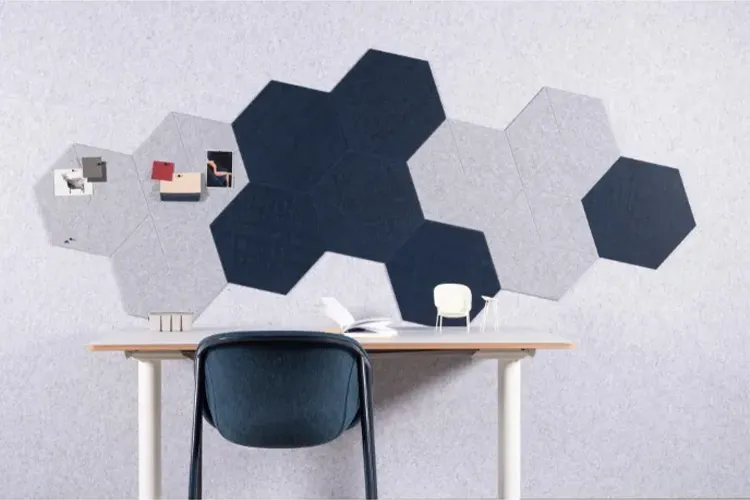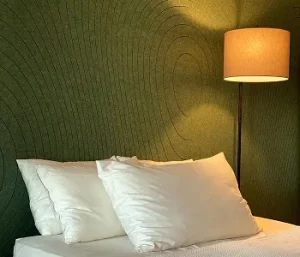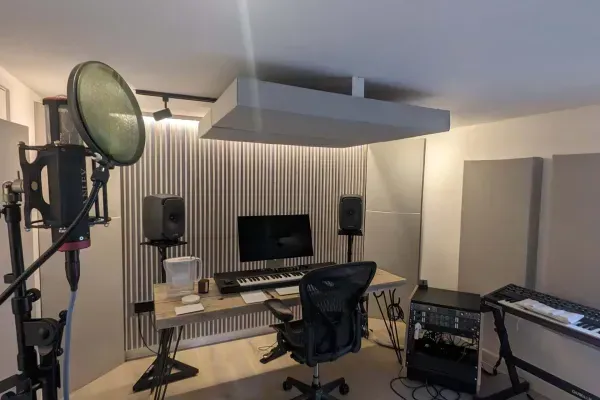Avoid your inquiry is delay response, please enter your WhatsApp/Skype along with the message, so we can contact you at the very first time.
We will reply you within 24 hours. If for urgent case, please add WhatsApp/WeChat: +86-13678899682 directly.
Noise leaks in, focus leaks out. Left alone, buzz, traffic, and voices steal your time. The fix is simple: use low-cost soundproof steps that add mass, seal gaps, and absorb echoes for peace and quiet.
To soundproof a room cheaply, first find where sound is coming in (door gaps, windows, bare walls). Seal air leaks, add dense curtains, lay a rug, and hang acoustic panels or bookshelves. Use weatherstripping, door sweeps, and DIY PET-felt panels that absorb sound. These quick moves block leaks and tame echoes fast.
When we soundproof any space, we balance three simple ideas: block, seal, and absorption. Blocking adds mass to slow sound transmission. Sealing closes air paths. Absorbing softens reflections so the room stops ringing. These are the soundproofing methods behind every good result.
Sound bounces off hard surfaces. That sound reflection builds up, so voices feel harsh. Adding soft, dense, acoustic finishes is the right soundproofing path: they absorb energy from sound waves, lowering echo (reverberation) and helping reduce sound in the space. That’s how soundproofing works in practice.
As a factory in China making PET and wood acoustic panels, we see the same pattern across offices, classrooms, and shops: simple, stacked steps effectively soundproof a room without heavy construction. Start small, then scale.
If you’re looking to soundproof a room, the cheapest stack is: seal the door, add curtains and window treatments, lay a thick rug, and hang dense wall hangings or shelves. This set gives fast wins and is easy to install.
Add more only where needed. A way to soundproof your room is to map noise paths, then place treatment only at the key spots. This targeted plan is both an affordable way and a smart one.

What is the cheapest way to soundproof a room
Start with soft mass. A heavy curtain over a window or thin wall helps dampen flutter echo. A big rug calms footfall and mid-high chatter. Thick curtains and window treatments plus framed wall hangings are cheap and easy ways to quiet a space.
Add storage with purpose. Put bookshelves against walls to add mass and trap mids. One simple way to soundproof a live room is to add furniture—sofas, drapes, and bookcases. Another room is to use dense materials (PET felt, wood slats). Even a small change in the room can help a lot.
If you don’t have room for deep modules, use thin PET-felt strips or narrow wood slats placed in clusters. They help to absorb flutter at ear height while keeping floor area clear.
Air gaps are noise highways. Install a door sweep and compressible weatherstripping to reduce sound transmission. These tiny parts cost little but can be effective soundproofing when stacked with soft finishes.
Check the latch side and the threshold. If light passes, so does sound. Plug cable cutouts and keyholes. Our team often starts here because a sealed door raises the whole system’s sound insulation before you add panels.
Traffic noise and voices enter through glass. Use double rods with layered fabric; thermal-mass soundproof curtains plus a tight seal at the trim lower leaks from outside noise. Caulk tiny gaps at the frame. For bigger improvements, add a removable acrylic panel inside. If budgets allow, soundproof windows are great, but you can wait until later.
Pick dense fabrics and overlap the jambs. That extra overlap boosts blocking and noise reduction. Keep the panel close to the wall to limit flanking.
Bare walls echo. Hang acoustic baffles or acoustic panels where people talk or where the mic sits. PET felt is light, safe, and easy to install. Wood-slat on PET adds style and more absorption. A few panels in first-reflection spots can be effective at soundproofing a room for calls or video.
If you’re trying to soundproof a room on a budget, diy soundproofing works well: glue PET felt to plywood, add Z-clips, and hang as a pair. This diy solution looks clean and beats random foam squares. If you like foam, use acoustic foam panels—great for flutter and high-mid control—but remember acoustic foam is for absorption, not heavy blocking.
We manufacture PET-felt and wood slat systems for OEM/ODM. That means custom sizes, quick lead times, and matched colors—factory-direct.

acoustic panels in room
Clap and listen. Then play pink noise on a phone and walk around. Mark the side where sound is coming through. Treat that surface first. In small rooms, also treat the first reflection on the opposite wall so speech stays clear. For stubborn paths, place panels on the opposite wall to break echo back-and-forth.
If a neighbor is loud, track noise from neighbours by time and side. Treat only the shared surface and edges. That way you reduce the noise with fewer parts.
For a shared existing wall, use layered approaches. Start with PET felt or wood acoustic modules on the hot spot. If needed later, add more insulation inside the cavity or a second layer of drywall with damping compound. That turns a live wall into a quiet, soundproof wall.
Ceilings matter. Add clouds to absorb chatter in open rooms. On floors over living spaces, use thick underlay plus a large rug. Each layer cuts a different leak. This is soundproofing an existing space the smart way—one step at a time.
To soundproof a bedroom, focus on door seals, window drape mass, and a few panels near the headboard. For a home studio, treat early reflections and corners near the mix spot; it’s one of the best ways to keep tracks clean. A true recording studio needs isolated framing, but that’s advanced.
No single step will completely soundproof a house room, and you don’t need it. Stack small moves. Add soundproof insulation only when structure is open. Use PET-felt for neat finish. This phased plan will soundproof the room enough for work, sleep, and calls.

soundproof a home studio
Below is a quick guide to soundproofing materials, their role, and typical budget bands.
| Item | Primary effect | Typical budget | Where it shines | Notes |
| Door sweep & weatherstrip | Seal gaps / block sound transmission | $10–$35 | Doors | Big win per dollar |
| Heavy curtain (layered) | Add mass / light block | $40–$120 | Windows, thin walls | Combine with caulk |
| Thick rug + pad | Footfall, room ring | $40–$150 | Hard floors | Warmer feel |
| PET-felt acoustic panels | Absorb echo | $60–$180 per set | Walls near talkers | Clean look, easy to install |
| Foam panels (select) | High-mid flutter | $20–$60 per set | Small calls booth | Not for blocking |
| Bookcases packed with books | Extra mass | $0–$200 | Shared walls | Doubles as storage |
Impact rating uses field experience from our B2B install teams; you can stack items to boost results.
Names can be tricky. Soundproof foam does not “block” like a wall; it absorbs mid/high energy. Use it to tune echo, not to stop bass leaks. Insulation inside walls helps too, yet heavy leaks still follow air gaps.
Labels help: NRC measures sound absorption (how much is absorbed), while STC estimates how well a wall slows sound transmission. Use NRC-rated acoustic finishes on surfaces; add mass and sealing for blocking. For more on NRC vs STC, see the Whole Building Design Guide (WBDG) and Energy Saver primers. WBDG – Sound Control • Energy Saver – Weatherstripping
Here are the best ways to soundproof in order. It’s a simple home improvement checklist:
Do steps 1–3 first. If more is needed, do 4–5. This keeps costs low without breaking the bank.
A designer was working from home with noisy neighbours next door. Step 1: we sealed the door. Step 2: we added two PET-felt clusters near the shared wall. Step 3: we hung a thick curtain across the window. This stack helped reduce noise during calls and looked clean.
Later, they added a cheap soundproofing solution—a movable felt screen—only for recording days. Layered, targeted moves beat “buy everything” shopping. That’s how you make your room calm while spending less.
We are a professional manufacturer in China focused on high-quality PET and wood acoustic systems. Distributors, designers, contractors, and brand owners trust us for custom sizes, exact colors, flame ratings, and global shipping. Our soundproofing solutions are modular and easy to install, so crews move fast.
Need a private label? We cut, groove, and finish to spec. If you need to soundproof offices, schools, hotels, or retail, our team can create matched kits (panels, trims, and mounting) that arrive ready to hang.
Can I make a room soundproof with only fabrics?
Fabrics tame echo but don’t add much mass. Use them to calm the room, then seal door gaps and treat the hot wall with PET-felt or wood-slat modules. Together, they absorb and block better.
What should I try first if I’m on a tight budget?
Seal the door, hang a dense curtain, and place a thick rug. Then add two acoustic panels at head height where people talk. These are ways to soundproof a room fast.
Are “foam squares” enough?
Use acoustic foam to kill flutter, not to block neighbors. Foam has high NRC but low mass. Pair it with seals and, if needed, extra insulation or layered board on an existing wall.
Do I need contractors?
Not for phase one. Most steps are easy to install with basic tools. If you plan structural work, consult local codes and an acoustics pro.
What if I’m trying to soundproof a bedroom near a busy road?
Use layered drapes, seal the frame, and consider a removable interior panel. Shift the bed away from the hot side and hang PET-felt where talk bounces.
What if I don’t know where the leak is?
Play a podcast in the next room. Walk the wall and listen. Treat the shared side and the first reflection on the opposite wall.
“Block, seal, absorb—then stop.” That’s the rule our install leads share with every B2B client.
Further reading: CDC – Noise & Health • WBDG – Sound Control • Energy Saver – Weatherstripping
Tell us your room size, surfaces, and use (calls, classroom, cafe). We’ll design a kit—PET felt or wood slat—cut to fit and color-matched to your brand. Global shipping, OEM/ODM labels, and fast lead times.